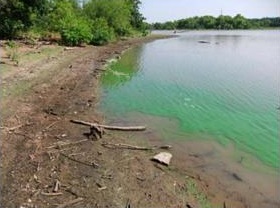
Agricultural News
Blue-Green Algae in Stock Ponds Can Threaten Livestock
Mon, 20 Jul 2015 12:03:00 CDT
 Dr. Josh Payne, Oklahoma State University Extension Poultry Specialist, writes in the latest Cow/Calf Corner newsletter.
Dr. Josh Payne, Oklahoma State University Extension Poultry Specialist, writes in the latest Cow/Calf Corner newsletter.
Cyanobacteria (blue-green algae) are microscopic organisms that can be found in all types of water including farm ponds. Being photosynthetic, they utilize sunlight to support life. For most of the year, the concentrations are low and the organism is homogenously suspended in the water. However, during hot, dry summertime conditions organisms can rapidly multiply resulting in high concentrations called blooms. The blooms may range in color from blue to bright green, brown or red and may resemble paint floating on the water or pea soup. Blooms are more common in warm, slow moving water that is nutrient enriched. Storm events followed by prolonged periods of hot temperatures can often trigger a bloom.
Some cyanobacteria can produce toxins that can be harmful to livestock affecting the nervous system and liver. Toxins affecting the nervous system can cause muscle tremors, difficulty breathing, convulsions and death while toxins affecting the liver can cause weakness, pale mucous membranes, bloody diarrhea and death. The wind can actually blow the algae bloom to one side of the water source, thus concentrating it. Dead animals may be observed near these concentrated areas.
The Oklahoma Animal Disease Diagnostic Laboratory can help identify the algae by sending them a pint container of the suspect water. The sample should be submitted in an unbreakable container such as a plastic water bottle. It should not be frozen but if it is shipped, provisions should be taken to keep it cool and out of sunlight. Since the blooms will deteriorate, a fresh sample is best. The fee for this test is $12.00. The lab can be contacted at 405-744-6623 for more information.
Prevention and monitoring are key to reduce livestock exposure to blue green algae. Below are some tips to consider:
-- Check livestock ponds for algae blooms in hot weather.
-- Fence off downwind drinking areas if blue green algae is present.
-- Pump water from deep within the pond to a nearby livestock tank.
-- Use other water sources, if available, when temperatures rise to high levels and algae blooms are observed.
-- Reduce nutrient inputs to ponds from runoff by applying fertilizer at least 100 ft away from the pond edge. Vegetative buffers on the upslope of ponds work well to trap sediment and nutrients.
-- Restrict livestock from having full access to water sources by fencing and installing limited access watering points or freeze proof tanks, thus limiting manure nutrient inputs.
-- Chemical treatment of the pond may kill the blue-green algae but any toxins contained in the cells will be released all at once. Therefore, it is best to reduce exposure and let the bloom dissipate on its own.
WebReadyTM Powered by WireReady® NSI
Top Agricultural News
More Headlines...



















